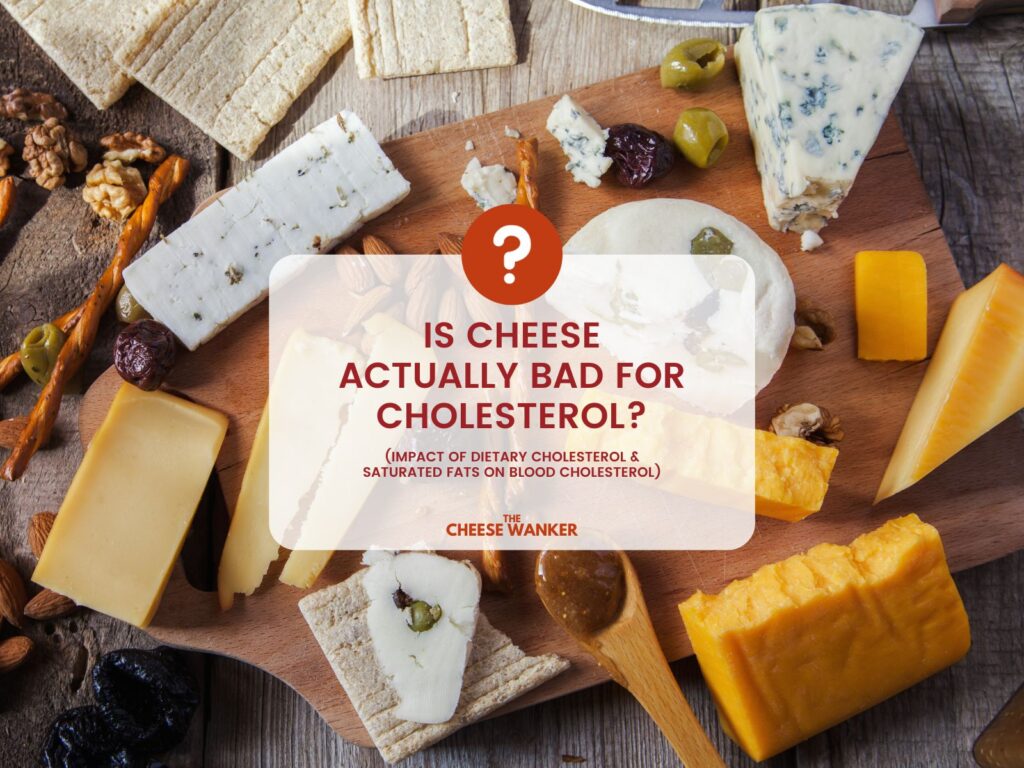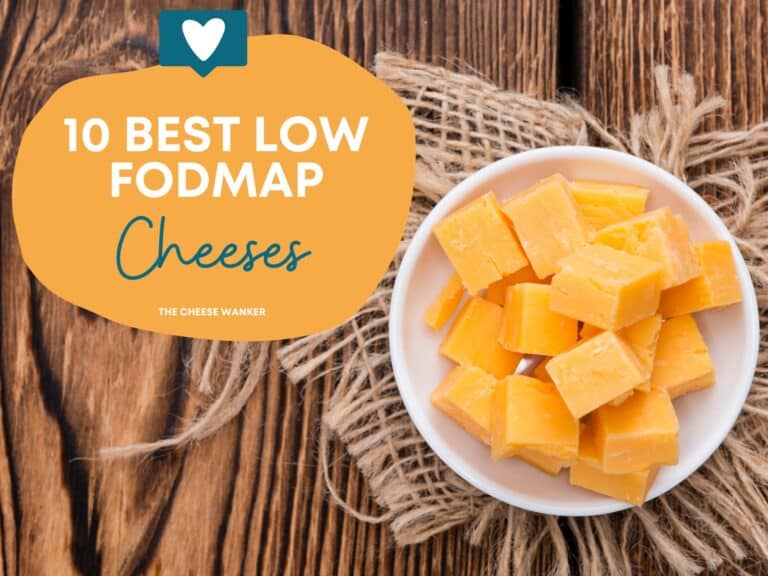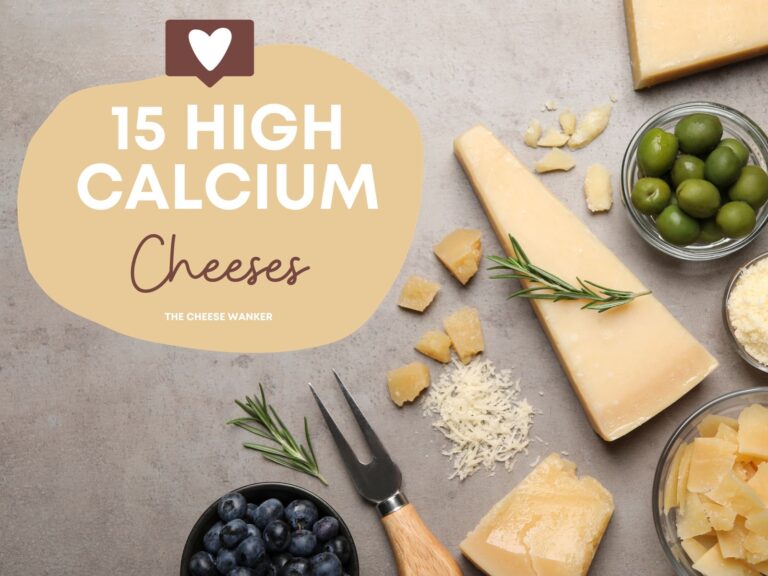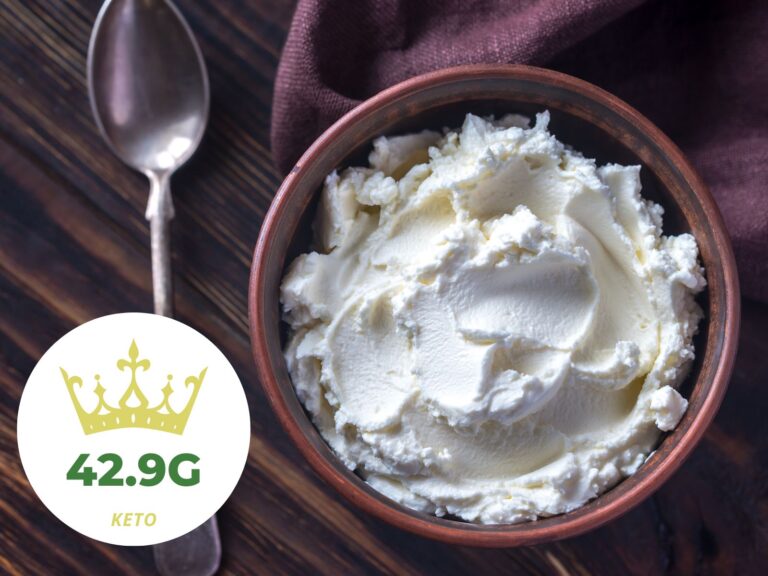Cholesterol has long been a topic of concern in the realm of nutrition and health. And cheese has come under scrutiny due to its cholesterol content and its potential impact on blood cholesterol levels. In this comprehensive exploration, we delve into the science behind the question: Is cheese bad for cholesterol? The answer might surprise you…

SEE ALSO: What are the healthiest types of cheeses based on nutritional profiles →
Understanding cholesterol
Before we take a deep dive into the topic of cheese and cholesterol, let’s cover some basics.
What is cholesterol?
Cholesterol is a lipid molecule essential for building cell membranes, producing hormones (such as oestrogen and testosterone), and aiding in the digestion of fat-soluble vitamins.
Our bodies naturally produce cholesterol, but it is also obtained from dietary sources. Some examples of cholesterol-rich foods include animal products like cheese, eggs and meat.
Different types of cholesterol
Cholesterol travels through the bloodstream attached to lipoproteins. Lipoproteins are complex molecular structures in the blood that play a crucial role in transporting fats, including cholesterol and triglycerides, throughout the body. They consist of a combination of lipids (fats) and proteins, hence the name “lipoproteins”.
Two key types of cholesterol are low-density lipoprotein (LDL) and high-density lipoprotein (HDL).
LDL cholesterol is often referred to as “bad” cholesterol because it transports cholesterol to tissues, including artery walls, where it can contribute to plaque formation.
On the other hand, HDL cholesterol is considered “good” cholesterol because it helps remove excess cholesterol from the bloodstream.
Dietary cholesterol vs. blood cholesterol
Additionally, it’s essential to distinguish between dietary cholesterol and blood cholesterol when discussing the impact of cheese on cholesterol levels.
These two concepts are often confused but play different roles in our overall health.
Dietary cholesterol
Dietary cholesterol refers to the cholesterol found in the foods we eat, such as cheese, eggs and meat.
Cheese does contain dietary cholesterol, but it’s important to understand that dietary cholesterol has a relatively modest impact on blood cholesterol levels for most people. The body has a sophisticated system for regulating cholesterol, and dietary cholesterol is just one piece of the puzzle.
Research has shown that while some individuals may experience a slight increase in blood cholesterol from consuming high-cholesterol foods, many others do not. The body compensates for the cholesterol we consume by producing less of it internally.
Therefore, dietary cholesterol, including that found in cheese, may not be the primary driver of high blood cholesterol in most cases.
Blood cholesterol
On the other hand, blood cholesterol refers to the cholesterol circulating in our bloodstream. It consists of LDL and HDL cholesterol.
The factors that most significantly influence blood cholesterol levels are the types of fats we consume, particularly saturated and trans fats. Cheese, especially full-fat and aged varieties, can contain significant amounts of saturated fat.
Furthermore, high saturated fat intake is known to raise LDL cholesterol levels for some individuals.
Research findings
Research exploring the relationship between cheese consumption and cholesterol levels has produced mixed results. While some studies have suggested that the saturated fat in cheese can raise LDL cholesterol, others have found no significant effect.
Moreover, it’s important to recognise that the impact of dietary cholesterol and saturated fat on blood cholesterol levels varies among individuals. Genetics, overall diet and lifestyle factors all play roles in determining how cheese affects cholesterol.
Nutrient variation across cheese types
Without a doubt, cheese is a rich source of macronutrients and minerals, being rich in proteins and calcium. However, some cheeses may be high in calories, saturated fats and sodium.
Furthermore, it’s important to note that the nutritional content of cheese can vary significantly depending on the type of cheese.
With that in mind, let’s take a look at the saturated fat content in 10 popular cheeses.
Five cheeses with a high saturated fat content
Mascarpone
Mascarpone, known for its creamy and luxurious texture, is an Italian cream cheese with relatively high fat content. With 30 grams of saturated fat and 43 grams of total fat per 100 grams, it’s undoubtedly a decadent choice.
Mascarpone’s mild, slightly sweet flavour makes it a versatile ingredient in both sweet and savoury dishes, from tiramisu to pasta sauces.
Its consumption, especially in large quantities, may have a notable impact on LDL cholesterol levels due to its saturated fat content. Moderation is advisable for those concerned about their cholesterol.
READ MORE: Complete nutrition facts for Mascarpone →
Manchego
Manchego, hailing from Spain, boasts a rich, nutty flavour. It contains 25 grams of saturated fat per 100 grams.
Traditionally made from sheep’s milk, Manchego’s aged varieties offer a strong savoury taste and crumbly texture. It’s a delightful addition to cheese platters and pairs beautifully with Spanish wines.
Regular consumption of this cheese, especially in large portions, may contribute to increased LDL cholesterol levels, warranting moderation in its intake.
READ MORE: Complete nutrition facts for Manchego →
Provolone Piccante
Next, we have Provolone Piccante, an Italian aged pasta filata cheese. It contains 22 grams of saturated fat and 30 grams of total fat per 100 grams. And its slightly spicy flavour makes it an ideal choice for sandwiches and salads.
Frequent consumption of this cheese, particularly when consumed in generous servings, could potentially lead to elevated LDL cholesterol levels.
READ MORE: Complete nutrition facts for Provolone Piccante →
Parmigiano Reggiano
Parmigiano Reggiano, often dubbed the “King of Cheeses,” is a beloved Italian cheese. With 21 grams of saturated fat per 100 grams, it’s a high-quality cheese with a rich, nutty taste.
Grated over pasta or risotto, shaved onto salads or enjoyed on its own, Parmigiano Reggiano is a gourmet delight.
Its impact on LDL cholesterol levels would be influenced by overall dietary choices and portion sizes. Enjoying it in moderation is a prudent approach. And enjoying Parmigiano Reggiano grated over food may be a safer option than eating it as a table cheese.
READ MORE: Complete nutrition facts for Parmigiano Reggiano →
Gruyère
Gruyère, a Swiss cheese with a sweet and slightly salty flavour profile, contains 21 grams of saturated fat per 100 grams.
Its creamy texture and meltability make it an excellent choice for fondue and quiches, while its distinct flavour elevates sandwiches and cheeseboards.
As with the examples above, moderation is advisable for cheese lovers who are concerned by their blood LDL levels.
READ MORE: Complete nutrition facts for Gruyère →
Five cheeses with a low saturated fat content
Caciotta
Caciotta, an Italian cheese, offers a milder taste with 13 grams of saturated fat and 20 grams of total fat per 100 grams.
It is often enjoyed fresh or aged, making it a versatile cheese that can be paired with fruits, bread or incorporated into recipes like pasta dishes and omelettes.
While it may have a milder impact on LDL cholesterol, prudent consumption is still recommended.
READ MORE: Complete nutrition facts for Caciotta →
Bocconcini
Next, we have Bocconcini which are small Mozzarella cheese balls. This bite-size cheese is known for its mild, milky flavour. With 11 grams of saturated fat per 100 grams, Bocconcini is a popular choice for Caprese Salads, sandwiches and appetisers.
As with Caciotta, this pasta filata has a moderate impact on blood LDL levels. Hence, consumption is still advised in moderation.
READ MORE: Complete nutrition facts for Bocconcini →
Fresh Chèvre
Fresh Chèvre, a creamy goat cheese, offers a delightful tangy and earthy flavour. It contains 11 grams of saturated fat and 18 grams of total fat per 100 grams.
Often enjoyed spread on crackers, mixed into salads or used in savoury and sweet recipes, Fresh Chèvre adds a distinctive taste to dishes.
Due to its low saturated fat content, this is usually a safe option for most people watching their blood cholesterol levels.
READ MORE: Complete nutrition facts for Fresh Chèvre →
Ricotta
Ricotta is known for its delicate and slightly sweet flavour. With 8 grams of saturated fat per 100 grams, it’s a versatile ingredient in both Italian cuisine and desserts.
Moreover, Ricotta is a popular ingredient sin dishes such as lasagne, stuffed pastas and cheesecakes.
Consumed in moderation, Ricotta is less likely to make a significant contribution to LDL cholesterol levels than most cheeses.
READ MORE: Complete nutrition facts for Ricotta →
Quark
Finally, Quark is a creamy and soft cheese with a mild flavour. It’s particularly low in saturated fat, with only 1.7 grams, and contains 3 grams of total fat per 100 grams.
This makes it a lower-fat alternative compared to many other cheeses. Quark is often used in European recipes for both sweet and savoury dishes, such as cheesecakes and spreads.
It is among the cheeses least likely to have a significant impact on LDL cholesterol levels when consumed in sensible amounts.
READ MORE: Complete nutrition facts for Quark →
Other strategies to lower LDL cholesterol levels
While moderating cheese consumption and choosing lower-fat varieties can be part of a strategy to manage LDL cholesterol levels, there are several additional lifestyle changes and dietary choices that can contribute to improved heart health:
- Increase fibre intake: Incorporating more soluble fibre-rich foods like oats, beans, lentils, fruits and vegetables into your diet can help lower LDL cholesterol levels. Soluble fibre binds to cholesterol in the digestive tract and facilitates its removal from the body.
- Choose healthy fats: Consume more unsaturated fats, such as those in olive oil, avocados and fatty fish like salmon. These fats can have a positive impact on LDL cholesterol.
- Physical activity: Engaging in regular physical activity can raise HDL (good) cholesterol and lower LDL cholesterol. Aim for at least 150 minutes of moderate-intensity exercise per week.
- Weight management: Losing excess weight, if needed, can lead to improvements in cholesterol levels. Even modest weight loss can have a positive effect on LDL cholesterol.
- Reduce trans fats: Minimise or eliminate sources of trans fats, often found in processed and fried foods. Trans fats can raise LDL cholesterol and lower HDL cholesterol.
- Limit added sugars: High sugar intake can contribute to obesity and metabolic disturbances, which can impact cholesterol levels. Reducing sugary beverages and sweets can be beneficial.
- Moderate alcohol consumption: If you consume alcohol, do so in moderation. Small to moderate amounts of alcohol may have a favourable effect on heart health, but excessive drinking can have adverse effects.
- Smoking cessation: Quitting smoking can lead to improvements in HDL cholesterol and overall cardiovascular health.
It’s essential to remember that individual responses to dietary and lifestyle changes can vary. Consulting with a healthcare professional or a registered dietitian can provide personalised guidance.
Conclusion: Consumption of cheese may not lead to higher blood cholesterol levels but…
In conclusion, whether cheese is “bad” for cholesterol depends on individual factors and dietary choices.
While cheese does contain dietary cholesterol, its impact on blood cholesterol levels is influenced by a multitude of factors, including genetics and overall diet. For most people, saturated fat intake has a more significant effect on blood cholesterol than dietary cholesterol.
Therefore, enjoying cheese in moderation, practising portion control and choosing lower-fat cheese options are prudent approaches to incorporating this dairy delight into a heart-healthy diet.
Ultimately, maintaining a balanced diet that includes a variety of foods like fruits, vegetables, whole grains and lean proteins is crucial for managing cholesterol levels.
If you have specific concerns about your cholesterol levels, consulting with a healthcare professional or registered dietitian is recommended to receive personalized guidance tailored to your health goals.
References
- Is There a Correlation between Dietary and Blood Cholesterol? Evidence from Epidemiological Data and Clinical Interventions – Maria Luz Fernandez and Ana Gabriela Murillo
- Saturated fat, carbohydrate, and cardiovascular disease – Patty W Siri-Tarino, Qi Sun, Frank B Hu and Ronald M Krauss
- Effect of cheese consumption on blood lipids: a systematic review and meta-analysis of randomized controlled trials – Janette de Goede, Johanna M Geleijnse, Eric L Ding, Sabita S Soedamah-Muthu



